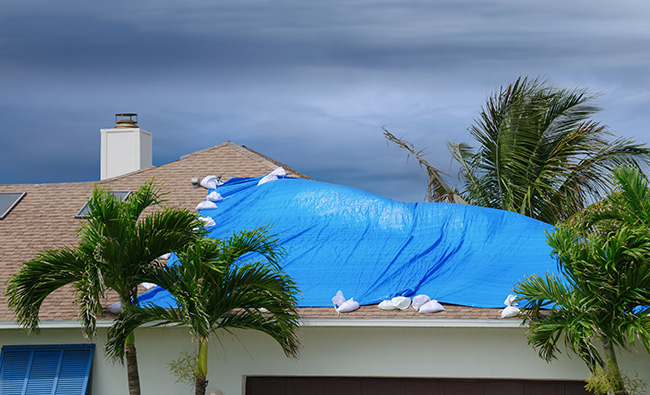
Key Takeaways
- Wind damage to roofs can occur from storms and hurricanes, leading to severe structural issues and water leaks if not addressed.
- Homeowners should inspect their roofs for signs of wind damage, such as missing or curled shingles, granule loss, and damage to gutters, to prevent further complications.
- Immediate action after discovering wind damage includes documenting the damage, contacting your insurance provider for claims, and hiring a professional roofing contractor for repairs.
Understanding Wind Damage to Roofs
Wind damage is a common yet often underestimated threat to roofs. Strong winds can strip shingles, cause structural damage, and lead to leaks and energy loss if left unaddressed.
Understanding the causes and types of wind damage helps mitigate its impact and maintain a robust roofing system.
What Causes Wind Damage?
Wind damage is primarily caused by severe thunderstorms, tornadoes, and hurricanes. Wind gusts from these severe storms, especially those above 74 mph, can cause severe roof damage. Severe weather, such as straight-line winds, can reach wind speeds of 100 mph or more, posing a significant threat to roofing systems and leading to severe storm damage. Additionally, monitoring wind speed is crucial for assessing potential risks during severe weather events, including the impact of a wind storm.
Types of Wind Damage
Wind damage manifests in various forms:
- High winds can lift and tear shingles, exposing the roof deck – resulting in leaks and further damage.
- Straight-line winds can severely compromise roofing systems.
- Granule loss in gutters indicates that shingles have lost their protective layer.
Identifying Wind Damage on Your Roof
After a windstorm, inspect your roof for damage. Visible signs include:
- Missing shingles
- Curling or lifted shingles
- You may also notice visible damage to soffit, fascia, or gutters. Regularly inspecting your roof can help identify potential issues and facilitate timely repairs, preventing further damage.
- Hail is present in some high-speed wind storms, so be aware and inspect for hail damage as well.
A thorough inspection is often necessary, as not all wind damage can be spotted from the ground.
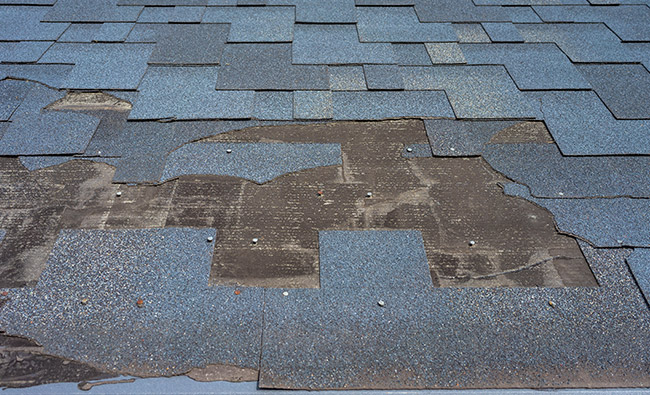
Missing Shingles
Missing shingles directly indicate wind damage. High winds can strip away damaged shingles, compromising the integrity of the roofing system. This visible damage requires immediate attention to prevent leaks and further deterioration. A missing shingle can lead to significant issues if not addressed promptly, including loose shingles and damage to the roof.
Professional roof assessments conducted twice a year can detect signs of wind damage that may not be visible to homeowners.
Lifted or Curled Shingles
Lifted or curled shingles clearly indicate wind impact:
- Windstorms can catch the edges of shingles, causing them to lift or curl.
- This breaks the adhesive seal, creating a non-water-tight surface.
- If left unrepaired, these shingles may eventually tear off entirely.
- This situation necessitates a professional roof inspection to avoid a total roof replacement.
Granule Loss
Granule loss in asphalt shingles is a critical indication of wind damage. Granules in gutters suggest shingles have lost their protective layer, exposing the underlying material to wear and potentially compromising the roof’s integrity.
Gutter and Fascia Damage
Damage to gutters and fascia can indicate that wind has compromised the roof’s ability to shed water effectively. Heavy rainfall can exacerbate existing issues, leading to significant water damage. Take action if you see damage on the edge of your roof. Be sure to contact a professional roofing company for an assessment.
Steps to Take After Discovering Wind Damage
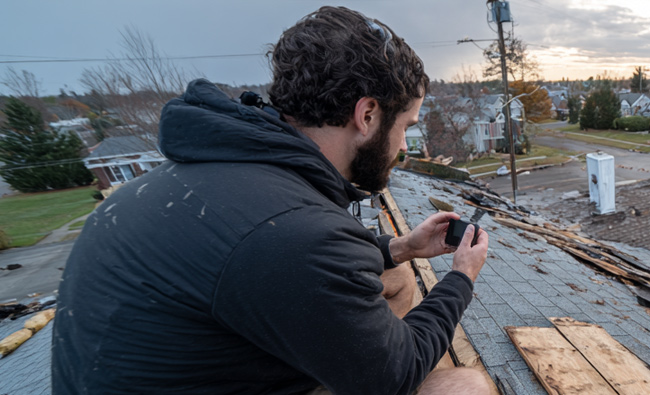
Discovering wind damage can be overwhelming, but immediate action is necessary to protect your home. Here are the steps to take:
- Document the damage with photos and notes for insurance claims.
- Contact your insurance company to file a claim.
- Have a professional inspection to assess the damage and identify necessary repairs.
Acting quickly ensures a smooth claims process and prevents further damage.
Ensure Safety First
Before inspecting roof damage, check for hazardous conditions, such as unstable surfaces or falling debris, to ensure safety. Safety is paramount; consider using binoculars or a drone for a preliminary inspection if climbing onto the roof is unsafe.
Document the Damage
Thorough documentation is key to a successful insurance claim. Here are the important steps to follow:
- Take clear photos and videos of the damage.
- Keep detailed notes of affected areas.
- Notify your insurance company promptly, as many policies have specific deadlines for reporting wind damage.
Maintaining organized records of all communications with your insurer enhances the efficiency of the claims process.
Contact Your Insurance Company
After discovering wind damage, contact your insurance agency promptly. Filing a claim should be your priority. Clear descriptions and evidence of the damage can expedite the claims process.
In addition to wind damage, many policies for home insurance also cover leaks. An insurance adjuster will assess all the damage and inform you of the coverage for repairs.
Repairing Wind Damage: Hiring a Professional Roofing Contractor
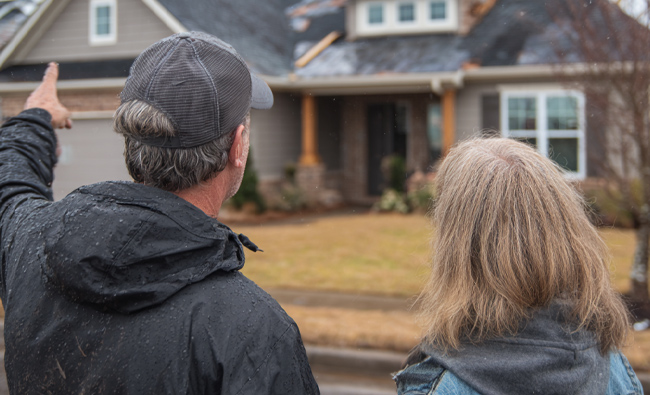
Hiring a professional roofing contractor is essential for effective wind damage repair. These experts:
- Possess the knowledge to assess and repair damage, ensuring safety and quality
- Handle both minor and significant repairs
- Provide damage assessments
- Assist with insurance claims
- Ensure that your roof repair is done correctly
Finding the Right Roofing Contractor
Selecting a reputable roofing contractor involves reviewing their previous work and customer reviews. Experience with local building codes is crucial for effective repairs.
A qualified contractor ensures that all damages are accounted for during the insurance adjuster’s assessment.
Getting Repair Estimates
Obtaining multiple repair estimates ensures the best coverage and helps avoid scams. A repair estimate includes a detailed action plan based on the contractor’s findings, with factors such as materials, size, and location influencing the cost.
Scheduling Repairs
Agree on the claim amount with the insurance company before starting repairs.
Once insurance approval is secured, coordinate with the contractor to schedule the repairs.
Preventing Future Wind Damage
Protective measures can significantly reduce the risk of wind damage to roofs. A comprehensive maintenance plan, regular inspections, and proactive strategies enhance the roof’s resilience against strong winds.
Regular Inspections
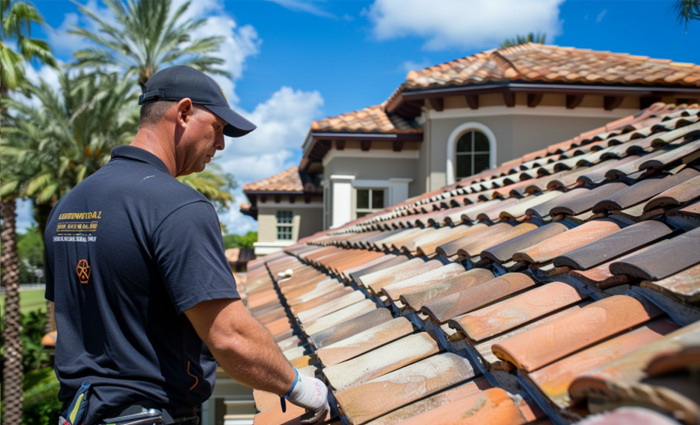
Periodic inspections enable homeowners to identify potential vulnerabilities before they escalate into severe issues. Annual inspections help spot minor problems that could escalate into major wind damage.
Strengthening Roofing Materials
High-quality and durable materials can strengthen a roof’s resilience against strong winds. Routine inspections identify wear and tear on roofing materials that may become vulnerable during high winds.
Maintaining Roof Vents and Gutters
Proper maintenance of roof vents and gutters prevents wind-related problems and ensures effective water drainage. Regular inspections and cleaning prevent clogged gutters, maintain the structural integrity of the roof, and avoid issues like pooling water.
The Role of Homeowners Insurance in Wind Damage
Homeowners insurance typically covers wind damage, a common cause of storm-related claims. Reviewing your insurance coverage policy to understand the specifics of your coverage is essential, as policies can vary significantly.
Qualified contractors may assist with the insurance claims process, potentially reducing out-of-pocket costs.
Understanding Your Coverage
Review your insurance policy beforehand to ensure adequate coverage for wind-related incidents. Examine your policy carefully to identify coverage limits and any exclusions related to wind damage.
Filing an Insurance Claim
Document the damage immediately with clear photos and detailed notes. Include this documentation when filing a claim and keep copies for your records.
A roofing contractor experienced with an insurance provider can assist with the claims process.
Navigating the Claims Process
To support your insurance claim:
- Take photos and notes of all visible damage.
- After documenting the damage, contact your insurance company to file an insurance claim and initiate the claims process.
- Provide all necessary documentation to your insurance company.
Wind Damage Summary
Unrepaired wind damage can quickly lead to costly problems. Understanding how to identify and repair wind damage, as well as taking preventive measures, can help protect your home from future storms. Proactive steps, like regular inspections and maintaining your roof, can save you from costly repairs. Stay vigilant, and ensure your roof remains a strong defense against the elements.
Frequently Asked Questions
How can I identify wind damage on my roof?
To identify wind damage on your roof, check for missing or lifted shingles, granule loss in the gutters, and any damage to the gutters and fascia. Ensuring these areas are intact is crucial for the roof’s integrity.
What should I do immediately after discovering wind damage?
Immediately ensure safety, document the damage with photos and notes, and contact your insurance company to initiate the claim-filing process. This proactive approach will help you address the issue effectively.
How can I prevent future wind damage to my roof?
To prevent future wind damage to your roof, conduct regular inspections and use high-quality roofing materials. Additionally, ensure that roof vents and gutters are well-maintained.
What role does homeowners’ insurance play in wind damage?
Homeowners’ insurance generally provides coverage for wind damage. It’s crucial to review your policy for the specific terms and conditions. Ensure you understand any limitations or exclusions that may apply to your coverage.
How do I choose the right roofing contractor for repairs?
Select a roofing contractor by verifying their reviews, evaluating their previous work, and confirming they are experienced with local building codes and insurance claims. This thorough approach will help ensure you hire a qualified professional for your repairs.
(352) 293-2449